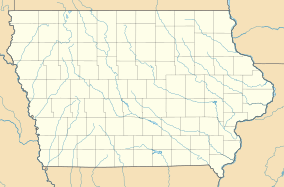Beeds Lake State Park facts for kids
Quick facts for kids Beeds Lake State Park |
|
|---|---|
| Location | Franklin, Iowa, United States |
| Area | 319 acres (129 ha) |
| Elevation | 1,135 ft (346 m) |
| Established | 1934 |
| Governing body | Iowa Department of Natural Resources |
| Website | iowadnr.gov |
|
Beeds Lake State Park,
Civilian Conservation Corps Area |
|

Bathhouse
|
|
| Area | 79.89 acres (32.33 ha) |
| Built | 1934-1938 |
| Architect | Central Design Office, Ames |
| Architectural style | Rustic |
| MPS | CCC Properties in Iowa State Parks MPS |
| NRHP reference No. | 90001672 |
| Added to NRHP | November 15, 1990 |
Beeds Lake State Park is a wonderful place for outdoor adventures! It's located northwest of Hampton, Iowa, in the United States. This park is special because part of it, known as the Civilian Conservation Corps Area, is listed as a historic district on the National Register of Historic Places. This means it's recognized as an important historical site.
The park covers about 319 acres and surrounds a beautiful 99-acre lake. There's so much to do here! You can go hiking on the trails, enjoy boating and fishing on the lake, or cool off with a swim. The park also has great spots for camping, picnic areas with shelters, lodges, and places to get snacks.
Contents
Discovering Beeds Lake State Park
A Look Back: How the Park Began
From Mill to Park: Early Days
Long ago, in 1857, a sawmill was built near Springbrook Creek, which was dammed to create power. A few years later, a flour mill was added. William Beed bought the property in 1864 and ran the mills until 1903 or 1904.
Later, between 1910 and 1913, the dam broke. The mill was taken down in 1916, and the 40-acre mill pond was drained the next year.
The Dream of a New Lake
Local groups, like the Izaak Walton League, wanted to create a much larger lake, about 120 acres, as early as 1926. They worked hard and were able to buy land for the park in 1933. The City of Hampton and other community groups then bought the property and gave it to the State of Iowa in 1934. The city asked for help from a special group called the Civilian Conservation Corps to develop a 258-acre park.
The Civilian Conservation Corps: Building the Park
The Civilian Conservation Corps (CCC) was a program during the Great Depression that put young men to work on important projects. From 1934 to 1938, the CCC played a huge role in building Beeds Lake State Park. They even set up their camp at the Franklin County Fairgrounds.
The CCC built the main dam and spillway between 1934 and 1936. By August 1937, the lake began to fill up! They also created five fish-rearing ponds nearby between 1936 and 1937. A causeway, which is like a raised road over water, was built on top of the old dam.
Many of the park's beautiful stone buildings and features were built by the CCC. The bathhouse was constructed from 1935 to 1936, and a footbridge was added in 1937. The beach next to the bathhouse was finished in October 1936. The large rocks used for the spillway and bathhouse came from fields nearby. Other historic features, like flagstone walkways and roads, were also built by these dedicated workers.
The park officially opened to the public on June 5, 1938, thanks to all their hard work.


